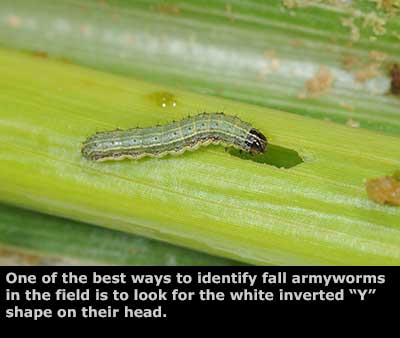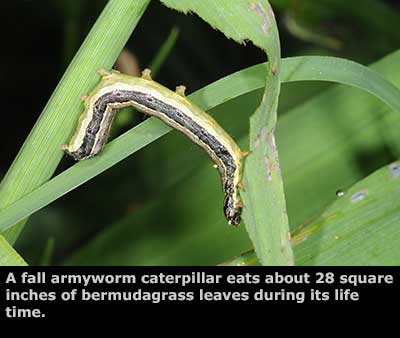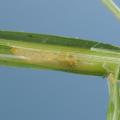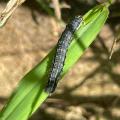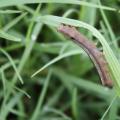Fall Armyworms
“That field looked fine when I drove by it Wednesday afternoon, but when I came back to cut it on Saturday it was nothing but stems!”
Fall armyworm, Spodoptera frugiperda, is the most damaging insect pest of bermudagrass hayfields. These caterpillars can destroy an entire cutting of hay in just a couple of days. The reason for this rapid crop loss is that the caterpillars do 80 to 90% of their feeding in the last two to three days of their life. During the summer months, fall armyworms remain in the caterpillar stage for around 10 to 14 days, but young caterpillars eat very little, and their damage is easy to overlook.
By the time they are ¾ to 1 inch long, fall armyworm caterpillars are leaf-eating machines that rapidly consume large amounts of leaf area. Multiply the leaf consumption of a single caterpillar by the hundreds of thousands of caterpillars per acre that occur during heavy outbreaks, and it is easy to understand how fall armyworms can cause such rapid defoliation. This is why experienced cattlemen and hay producers learn to scout their fields every two to three days during periods when fall armyworms are a threat and to have their spray equipment ready to go.
See Extension Publication 2717, Fall Armyworms in Hayfields and Pastures for fall armyworm treatment recommendations and information on fall armyworm biology and how to best protect bermudagrass hayfields from this damaging pest.
Publications
News
Following last year’s significant fall armyworm outbreak, hay producers should be careful not to overlook another important pest -- the Bermudagrass stem maggot -- while watching for armyworms. While farm armyworms attack hay fields, home lawns, golf courses and more, the non-native Bermudagrass stem maggot is primarily a pest of hay fields.
Lawns, pastures and even winter food plots are at risk as an insect army advances across much of the state in higher than normal numbers. Blake Layton, entomologist with the Mississippi State University Extension Service, said fall armyworms are the most damaging insect pests of bermudagrass hayfields and pastures
Every year, lawns and pastures become targets for late-summer grass-eating caterpillars, making it important to watch for the usual suspects and some culprits that are less common.


